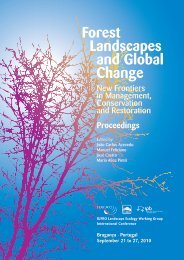Programa e Resumos - I Congresso Ibérico de Ciência do Solo 2004
Programa e Resumos - I Congresso Ibérico de Ciência do Solo 2004
Programa e Resumos - I Congresso Ibérico de Ciência do Solo 2004
You also want an ePaper? Increase the reach of your titles
YUMPU automatically turns print PDFs into web optimized ePapers that Google loves.
I <strong>Congresso</strong> Ibérico da Ciência <strong>do</strong> <strong>Solo</strong> – 15 a 18 <strong>de</strong> Junho <strong>de</strong> <strong>2004</strong>, Bragança, Portugal<br />
Effects of Zn on Bromus rubens L. in a Polluted Calcic Luvisol Soil.<br />
Potential Use of the Species in Revegetation and Phytoremediation.<br />
Ana J. Hernán<strong>de</strong>z Sánchez 1 & Jesús Pastor Piñeiro 2<br />
1 Departamento Interuniversitario <strong>de</strong> Ecología, Universidad <strong>de</strong> Alcalá, Alcalá <strong>de</strong> Henares<br />
(Madrid). E-mail: anaj.hernán<strong>de</strong>z@uah.es<br />
2 Departamento <strong>de</strong> Biología Ambiental. Centro <strong>de</strong> Ciencias Medioambientales, CSIC, Madrid.<br />
E-mail: jpastor@ccma.csic.es<br />
Abstract<br />
Comunicação: Painel<br />
The most heavily metal polluted soils in central Spain are found in areas occupied by<br />
aban<strong>do</strong>ned mine lands and old urban and industrial waste landfills. Zn is the most<br />
extensively dispersed pollutant and can reach phytotoxic concentrations.<br />
Although several plant species are known to take up metals from the soil, the different<br />
ability of these species to <strong>do</strong> so has not yet been established, and because of their<br />
particular ecologic characteristics, many are unable to grow in the conditions of the area<br />
examined in the present study. Unfortunately, there is a lack of relevant data on the<br />
phytoremediation and revegetation potential of native plant species able to grow in<br />
polluted and <strong>de</strong>gra<strong>de</strong>d soils in xeric environments. One such species is Bromus rubens<br />
L., a native plant that grows in xeric grass and shrub lands.<br />
The area un<strong>de</strong>r study was previously screened to establish which species grew best by<br />
stratified sampling and performing plant inventories. Soil samples were obtained from<br />
<strong>de</strong>gra<strong>de</strong>d and polluted environments in xeric areas and from reference, neighbouring<br />
herbaceous ecosystems.<br />
Bromus rubens L. was found in 44 sites. Their ecological profile indicated a preference<br />
for the soils of highest Zn levels. When Zn was <strong>de</strong>termined in plants collected from<br />
these soils, Zn levels in the red brome were found to increase as the Zn concentration of<br />
the soil rose.<br />
In a pot experiment on a calcaric luvisol, increasing soil Zn content was observed to<br />
mostly affect the root levels of this metal, but raised contents were also <strong>de</strong>tected in the<br />
aerial part of the plant. Root Mn and Mg were also seen to rise with increasing Zn<br />
levels. In the aerial part of the red brome, soil Zn was associated with increased Cu and<br />
Ca, and lower Mg levels.<br />
Collectively, the results suggest that this species is able to accumulate significant Zn<br />
concentrations. The relatively good size and soil cover achieved by the red brome in<br />
polluted soils, means it could be a suitable candidate for use in studies directed towards<br />
the revegetation and phytoremediation of xeric <strong>de</strong>gra<strong>de</strong>d soils as those examined here.<br />
Acknowledgements: This study was fun<strong>de</strong>d by the REN2002-02501/ TECNO project.<br />
– 96 –
















